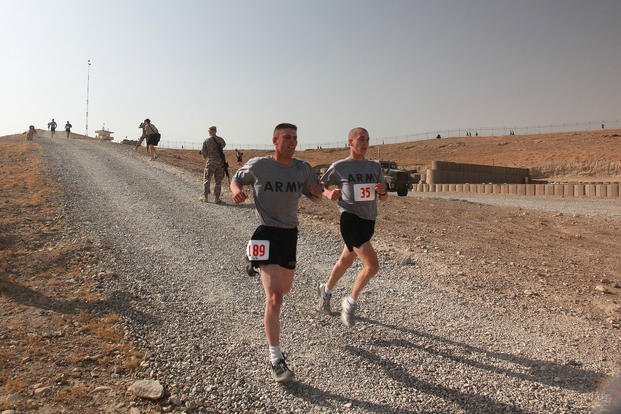Hills can be a great way to make running harder. However, running too fast downhill can increase the chances of lower-limb injuries or falling. Here is a question from a young man who trains in an area where there are many hills, which can be both good and bad.
Stew, where I live there are a lot of hills. Is there any downside to running hills exclusively but at a slower pace per mile? I am training for timed runs on the Marine Corps fitness test (3 miles) as well as the Combat Fitness Test of a fast 800 meters. What do you recommend? Justin
Justin, there are definite pros and cons to hill running. Make sure you set goals so you can focus on what matters and assess throughout the preparation phase.
Here are some clever ways to work on your pace, leg strength and endurance while reducing injuries. Using the SMART acronym for goal setting, we’ll break it down like this:
S: Specific
You should definitely train for a three-mile timed run and 800-meter run. You just need to figure out your goal pace. Progressing from an eight- to a seven-minute mile does not usually take much time, but getting from a seven- to a six-minute mile may take a longer time, depending on your athletic history and current training abilities.
M: Measurable
You do need to find a somewhat accurate way to measure these distances and times. My advice is find some flat ground, even if it is only a quarter-mile or 400-meter road. Finding a high school track is even better. The last resort would be to do these running tests on a treadmill.
A: Attainable
Attainable goals just mean that you need to be patient with the process as you design a running program that helps you see regular improvements. If you start off with too many miles per week and no strategy for uphill and downhill running, you will have a recipe for lack of progress and potential injury.
R: Realistic
You may want to be a Marine, but you need to know that being a Marine is much more than just three-mile timed runs and 800-meter sprints for physical fitness tests (PFTs) and combat fitness tests (CFTs). There is muscle stamina preparation for calisthenics and strength training for load-bearing activities like rucking, log PT and other equipment carry.
Make sure you are doing more than just endurance running. If running is a weakness, more running training should be on the training table. Just don’t neglect other physical traits to focus solely on improving your running.
T: Time Bound
You may have a timeline that is set in stone for when you want to join the Marines. If you do not, set a performance starting line instead of an arbitrary timeline to join. You want to be physically prepared for the challenge of Marine boot camp and the fitness challenges you will face with testing and the general grind of training.
For your situation, try this:
1. Long and Slow Distance Days
Consider a steady-paced run once a week and put in some miles if you can handle the distance. When arriving at a hill, lean into the hill going up and push to maintain the pace without sprinting. Going downhill is where you need to be careful. Shorten the stride to avoid the additional ground forces and heel striking that can occur during downhills.
If there are dirt trails, consider these as the impact forces are significantly less, compared to pavement, and better for your feet. Watch for ankle-breakers on trails, as holes and roots hidden by leaves can stop your running training for weeks.
2. Goal Pace Running
If you find some flat running surfaces (track, treadmills, trail), use these areas to practice goal pace running. If you want a six-minute mile, practice 1:30 quarter-miles and three-minute half-miles. Do multiple sets with 100- to 200-meter walks between each set. I would do this 2-3 times a week.
3. Faster than Goal Pace Running
You can do this one on a hill or a track if available and work on your legs moving faster and heart and lungs working harder. Try this: Find a hill that is near 400 meters at a steady incline. Sprint up it and walk down as recovery time. Repeat that 5-10 times, depending on whether you had to run to get to this hill.
We have a hill like this one and mix in leg calisthenics like squats, lunges and fireman carries with a person or sandbag. It takes us two miles of flat running to get to the hill, then we do five hill sprints with squats and lunges at the top of each set.
The sixth hill is a fireman's carry, with a partner trading out carrying sets up the hill until you get to the top. Then we run back to where we started, mixing in some goal pace intervals and walk recovery as needed.
I hope this gave you some ideas for your running training. Hills are great training tools. For you to run, ruck and sprint hills on different days of the week will be a great way to diversify your training. Final note: Make sure you have a good pair of running shoes, as hills are rough on the feet and knees.
-- Stew Smith is a former Navy SEAL and fitness author certified as a Strength and Conditioning Specialist (CSCS) with the National Strength and Conditioning Association. Visit his Fitness eBook store if you're looking to start a workout program to create a healthy lifestyle. Send your fitness questions to stew@stewsmith.com.
Want to Learn More About Military Life?
Whether you're thinking of joining the military, looking for fitness and basic training tips, or keeping up with military life and benefits, Military.com has you covered. Subscribe to Military.com to have military news, updates and resources delivered directly to your inbox.


















